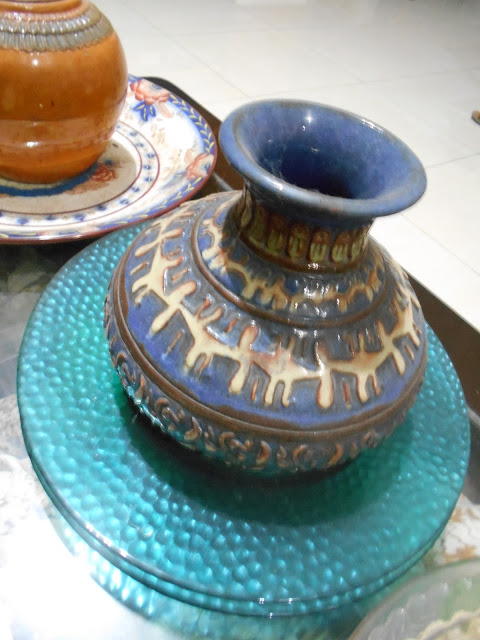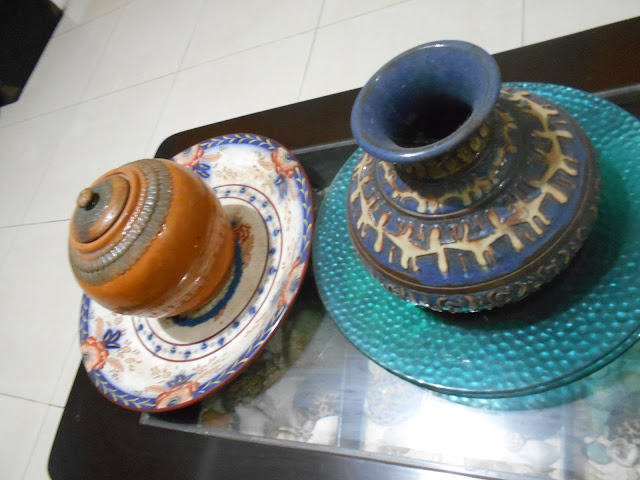The Charm of Postwar Japanese Porcelain: A Vintage Tea Set Collection
Introduction
Amid the quiet glow of evening light, a delicate porcelain tea set rests gracefully on marble. Each cup reflects a bygone era — a time when craftsmanship and refinement were woven into everyday rituals. The golden handles, iridescent glaze, and floral motifs evoke a sense of nostalgia and elegance. This is not just a set of tea cups; it is a fragment of history — a story of Japan’s artistry, resilience, and its postwar renaissance in fine ceramics.
Origins and Historical Context
The backstamps on the underside of the pieces — “JAPAN” in gold and “MADE IN JAPAN” in green — trace this collection to Japan’s post–World War II export period, roughly between the late 1940s and the 1970s. During this era, Japanese porcelain makers regained their international reputation for quality and aesthetics after years of wartime disruption.
Following the U.S. occupation (1945–1952), Japan began exporting vast amounts of handcrafted ceramics to Europe and America. These exports were prized for their elegant lusterware glazes, gilded decorations, and intricate floral designs, all offered at affordable prices compared to European porcelain. Many of these pieces were made by regional kilns and family-owned factories, distributed under various trade names such as Royal Sealy, Lefton, UCAGCO, or Sango.
Design and Aesthetic Qualities
This particular tea set captures the quintessential charm of mid-20th-century Japanese lusterware. Each piece glows with an iridescent, pearl-like sheen that subtly shifts in color under light. The handles and rims are accented with gold, adding a touch of luxury to the soft white porcelain base.
The floral motif, featuring classical Western-style bouquets in rich tones of pink, red, and green, reveals Japan’s mastery of cultural adaptation — blending European decorative trends with the precision of Japanese craftsmanship. The meticulous gilding and symmetry suggest the pieces were at least partially hand-decorated, a hallmark of higher-quality postwar export ceramics.
The Companion Pieces
The display also includes larger ceramic items — a sepia-toned transferware tray and pitcher featuring a pastoral watermill scene. These may originate from a different series or even another maker, likely inspired by English country pottery traditions such as those of Johnson Brothers or Staffordshire. Their earthy brown tones provide a rustic contrast to the tea set’s delicate luster and gold, creating a balanced and visually rich tableau.
Cultural and Collectible Value
Though mass-produced for export, each of these Japanese porcelain pieces represents an era of cultural exchange and artistic revival. The 1950s–1970s were marked by Japan’s commitment to rebuilding its reputation through meticulous craftsmanship. Such tea sets were often gifted at weddings, displayed in china cabinets, or used during festive family gatherings.
Today, collectors value them for their craftsmanship, vintage charm, and nostalgic symbolism. A complete set in good condition — with intact gilding and no cracks — can fetch $60–150 USD or more, depending on maker and rarity. Yet their greatest worth often lies beyond market value: they preserve the quiet grace of an era when artistry found expression in the ritual of tea.
Conclusion
The golden-handled teacups and iridescent saucers of this Japanese porcelain set are more than decorative treasures — they are storytellers. They whisper of Japan’s postwar resilience, of beauty reborn through craftsmanship, and of the timeless art of gathering over tea. Whether admired for their historical significance or cherished for their aesthetic harmony, these pieces remain a glowing testament to the union of function, artistry, and enduring grace.
Vintage tea set and ceramic collection arranged on a marble table.
🫖 Main Elements
-
Tea Set (Foreground)
-
Composed of several pieces, including:
-
A teapot with a lid and golden handle.
-
A sugar bowl and creamer, both with matching gold detailing.
-
Six cups and saucers decorated with floral motifs, likely featuring roses and fine gold embellishments.
-
-
The design style resembles European porcelain, possibly English or German, given the ornate floral patterns and gilded rims.
-
-
Large Ceramic Tray (Background, Left)
-
The tray is decorated in sepia tones, depicting a watermill scene surrounded by trees and a fence.
-
This rustic motif suggests it could belong to a transferware style, common in 19th–20th century English ceramics.
-
-
Large Pitcher and Basin (Background, Right)
-
Also featuring the same watermill motif, matching the large platter.
-
This could be part of a wash set, traditionally used in bedrooms before indoor plumbing became common.
-
🎨 Style and Craftsmanship
-
The contrast between the floral tea set (white, gold, and pink) and the rustic brown transferware pieces indicates that these are likely from different series or makers.
-
The gilded floral set may date from the mid-20th century, reflecting the Rococo revival or Victorian-inspired designs popular in porcelain at the time.
-
The brown pastoral scene pieces likely date slightly earlier or are made in a classic English country style, reminiscent of Johnson Brothers or Royal Staffordshire.
🏷️ Possible Origins
-
Floral gilded set: Central European (e.g., Bavaria, Czechoslovakia) or English bone china.
-
Brown pastoral set: English transferware, potentially from the Staffordshire region.
💡 Condition and Display
-
The pieces appear in good condition with minimal visible cracks or chips.
-
The setup suggests they’re display items, not for daily use—possibly part of a vintage or family collection.
Would you like me to help identify the makers or estimate the era/value of the set based on visible marks or patterns? If so, please upload a close-up of the backstamps or maker’s marks on the underside of any of the pieces.
🏷️ Backstamps Analysis
-
First Mark (“JAPAN” in gold)
-
This simple gold-stamped mark was commonly used on Japanese porcelain exported between the late 1940s and the 1960s.
-
The font style and placement (usually centered on the base) match post–World War II export ceramics.
-
Many of these were hand-decorated or lusterware pieces made for Western markets, especially the U.S.
-
-
Second Mark (“MADE IN JAPAN” in green)
-
The phrase “Made in Japan” was used from 1921 onward, replacing “Nippon” after U.S. import laws changed.
-
However, the hand-stamped green ink and simple typeface you have here indicate post-World War II (c. 1950s–1970s) production rather than pre-war.
-
This style was typical of companies like Noritake, Lefton, Occupied Japan-era makers, or smaller regional kilns producing export tableware.
-
🍶 Origin & Style
Your tea set, with its iridescent glaze, floral motifs, and gilded trim, fits the profile of mid-20th-century Japanese lusterware, which was highly collectible in Europe and America.
These were often sold in department stores or imported by brands such as:
-
Royal Sealy Japan
-
Lefton China
-
Takito or Sango
-
UCAGCO Japan
🌸 Summary
| Feature | Description |
|---|---|
| Country of Origin | Japan |
| Era | 1950s–1970s |
| Material | Porcelain with luster glaze and gilded accents |
| Style | Decorative tea set, often given as wedding or export gifts |
| Value (approx.) | $60–150 for a complete set in good condition (collector’s range varies by rarity and maker) |
If you’d like, I can help you narrow down the likely maker (e.g., Lefton, Royal Sealy, etc.) — could you upload one more photo showing the front design pattern clearly on a teacup or teapot? The floral motif and gold detailing style are key identifiers.













